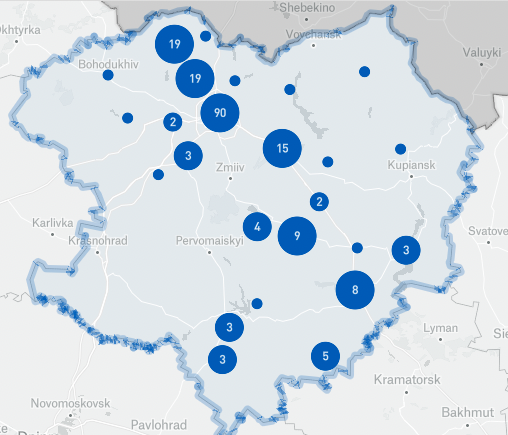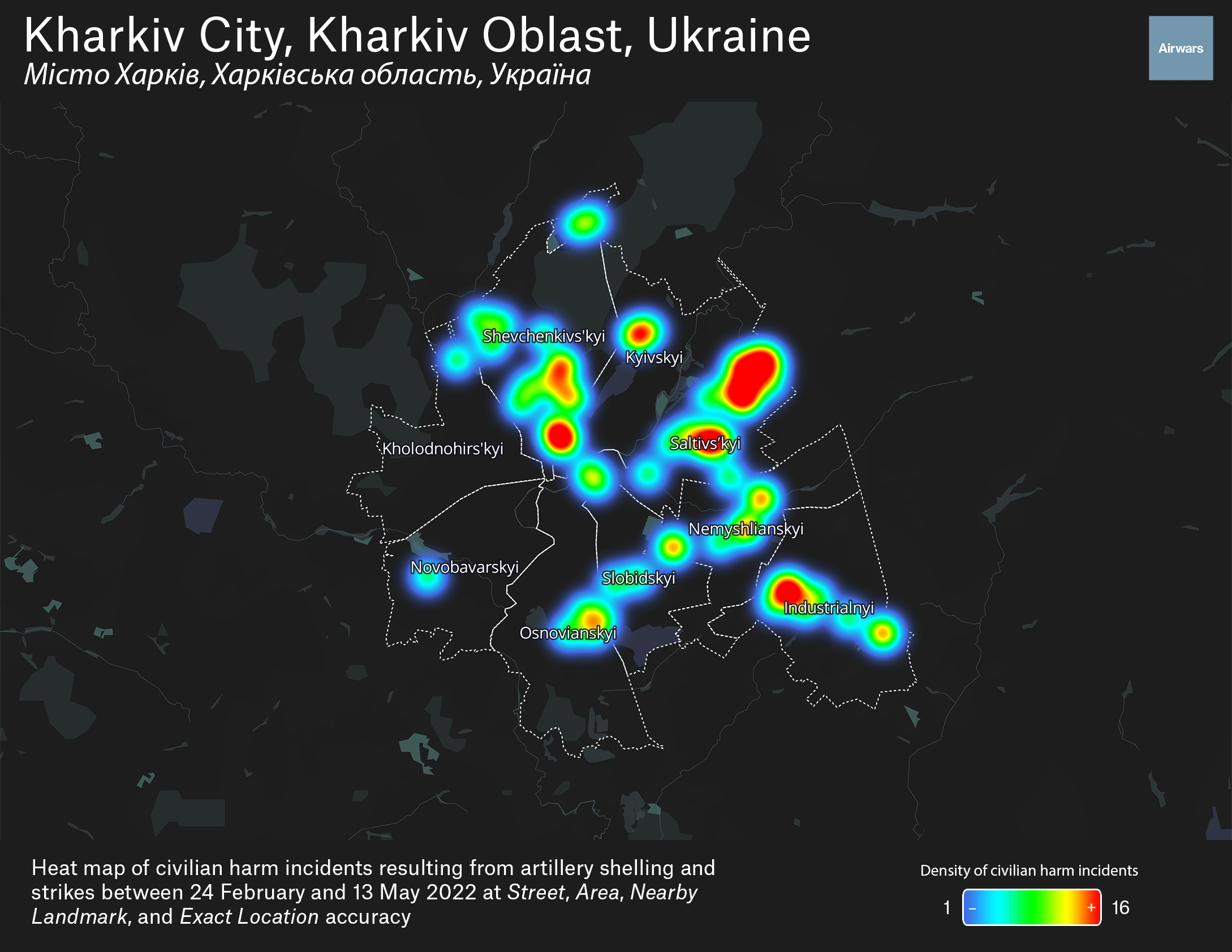Archive of civilians killed and injured in Ukrainian region among the most in-depth public documentation to date
A mother killed cradling her child in her arms, an elderly woman hit by shrapnel while feeding stray cats, a family buried under rubble for weeks – these are among hundreds of devastating human stories recorded in Airwars’ new Ukraine research portal, among the most in-depth public documentation of the war’s human impact to date.
Over nine months, Airwars’ new Ukraine research team documented every publicly reported civilian harm allegation from explosive weapons in the ‘Battle of Kharkiv,’ which lasted from the Russian invasion on February 24th until May 13th 2022.
The data can be explored via Airwars’ interactive mapping, civilian harm database and urban heat map. Our findings are accessible through our full research brief here along with a methodology note. The project was designed as a sample case for building a publicly accessible database of allegations of open-source civilian harm in Ukraine. The figures do not claim to be exhaustive.
Among the key findings were:
-
- At least 275 and as many as 438 civilians were reported killed by explosive weapons during the period under review. In addition, between 471 and 829 civilians were reported injured.
- Where the identity of the victim was reported by local sources, Airwars identified that at least 30 children, 52 women and 61 men were likely killed by Russian actions.
- In at least 60 incidents (nearly a third of all allegations), civilians were reported to have been killed or injured at home when Russian artillery shelling or strikes hit residential buildings or houses.
- The war had a devastating impact on infrastructure throughout the city. At least 16 civilian harm incidents involved strikes or artillery shelling that hit hospitals and other medical facilities.
- In 95 percent of reported civilian harm incidents there were no accompanying reports of military casualties or damage to military objects, despite Russian claims that they only target legitimate military sites.
- In the single worst civilian harm incident recorded, on March 9th, between 44 and 54 civilians were killed, including up to six children, in strikes and shelling in Izyum on a a five story building.
- Compared to other conflicts monitored by Airwars, there was a significant lack of publicly named victims – most likely the result of Ukrainian government policy on data protection and privacy.

A screengrab of Airwars’ interactive database of civilian harm in Kharkiv
Battle of Kharkiv
Airwars is the world’s leading civilian harm watchdog and has tracked the human impact of military intervention in conflicts for a decade, including the US-led Coalition against the Islamic State and the Russian military in Syria.
The war in Ukraine has led to an unprecedented focus on civilian harm, but the scale of violence has overwhelmed all casualty assessment mechanisms. Numerous projects have been launched, some open-source and others involving on-the-ground investigation. These casualty counting efforts are cumulative, with each bringing different details to the fore. The purpose of such efforts is ultimately to build an evidence base for justice and accountability while giving a sense of the scale of loss.
After consultation with international and Ukrainian partners about gaps in such casualty recording, Airwars focused its pilot programme on the Battle of Kharkiv.
The second largest largest city in Ukraine, Kharkiv has been among the hardest hit urban areas in the war. Located some 40km from the Russian border, with a large Russian speaking population and close ties to Moscow’s economy, it was a key target when the Russian invasion began on February 24, 2022.
As Russian forces invaded Ukraine from multiple directions, thousands of troops entered the Kharkiv region. Cities and villages were heavily shelled. In a few weeks key towns and cities in Kharkiv oblast were occupied by Russian forces, including Izyum, Kupiansk and Balaklia. Kharkiv city itself was never occupied but instead became the scene of intense fighting and a mass exodus.
At the end of April 2022, Ukrainian forces began a counter offensive in Kharkiv. By May 13th, Russian forces were pushed from the surroundings of the city – with the Battle for Kharkiv declared won. It took several months more for Ukrainian forces to reclaim other towns occupied by Russia in the Kharkiv Oblast.
Human suffering
Airwars’ research, conducted over nine months by our Ukrainian research team, involved painstakingly bringing together all publicly reported details about individual civilian harm allegations. In total, the researchers tracked 200 civilian harm allegations caused by explosive weapons during the time period. Each of these has its own dedicated assessment and page on the Airwars website. In almost all cases, the Russian military was alleged to be the sole responsible.
These cases tell the story of the war at large, but also of individual suffering. Neighbours killed while about to have lunch together, a 96-year-old Holocaust survivor killed at home – heartbreaking stories that make up a wider pattern.
On March 17th 2022, a mother was killed when her home was hit during shelling overnight. Reports said she was cradling her four-year-old daughter in her arms to protect her. The child survived.
Airwars researchers also tracked damage to infrastructure, with healthcare facilities among the most commonly struck. Airwars documented damage to 16 healthcare facilities in incidents where civilians were also killed or injured. Among these were hospitals, a blood donation centre, a pharmacy, as well as an ambulance. On March 3rd, a Syrian doctor, described as a gynaecologist originally from Deir Ezzor, was killed when an alleged Russian mortar hit the Kharkiv Regional hospital.
In a pattern similar to what is often reported in Syria, Airwars also tracked three allegations of so-called double-tap strikes, where a strike is followed by a second round of strikes as emergency services or nearby civilians respond to the incident.
In 95 percent of cases only civilians harmed
A key debate throughout the war has been the extent to which Russian forces have been striking legitimate military targets. Russian officials accuse Ukraine of placing military targets near civilian population centres, while Ukraine has claimed that the strikes are deliberately indiscriminate.
Our data shows that in 94.5% of cases where civilians were reported killed or injured (189 incidents), local sources reported that civilians were the only victims of Russian actions, and did not mention any military objects or Ukrainian military personnel killed.
While public reporting on Ukrainian military casualties is forbidden under Ukrainian law, which may be a factor in the relatively low numbers, this is a finding that echoes other on the ground reporting from human rights organisations, such as Human Rights Watch.
The Ukraine information environment has a number of factors that differ from other conflicts monitored by Airwars – most prominently regarding the identities of victims. In Ukrainian language reporting there has been little mention of names of victims, and limited information related to their gender, age or occupation. This differs dramatically from other conflicts Airwars monitors, including US airstrikes in Yemen and Iraq, Russian bombing in Syria, and Israeli bombardment in Gaza and Syria, and presents a challenge for wider casualty recording efforts.
As an example, in one intense month of Russian and Syrian government bombing of the Syrian city of Aleppo in July 2016, our team tracked 76 different civilian harm incidents – in which we recorded 187 named victims. In March 2022, in the Kharkiv region, we tracked 70 separate civilian harm incidents from Russian strikes, but only a total of 37 named victims.
There are a number of potential reasons for this gap. A key factor is Ukraine’s privacy policy that is being applied by authorities to protect civilians’ identities. This allows the release of names only when approval has been given by the victim or their family.
In Iraq, Libya, Somalia and Syria such official structures are either lacking or distrusted by civilians. As such civilians have been forced to fill the gaps – posting details of the dead on social media, particularly Facebook. In contrast Ukraine has a functioning state, with security, investigative, forensic and medico-legal structures that worked to record civilian harm since earlier Russian advances on the country.

